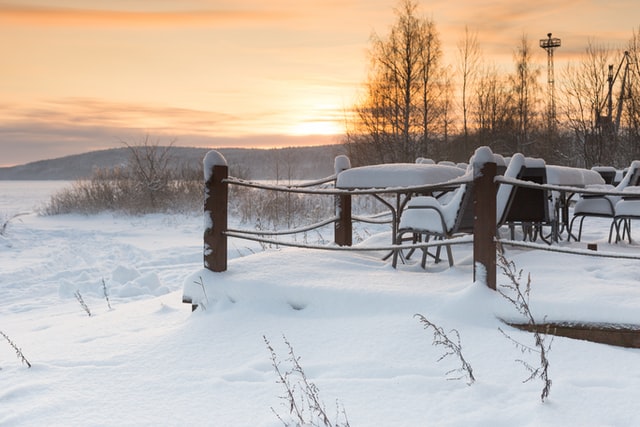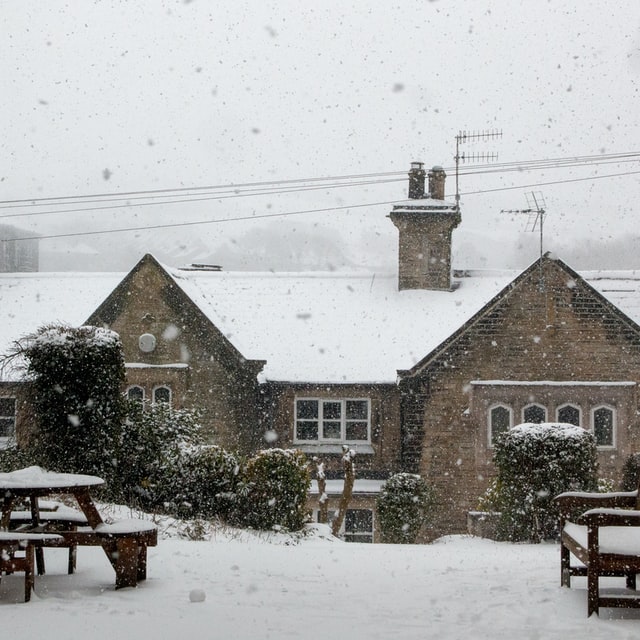As much as we resist, it is time to prepare our garden for the cold months. And, from the list of things to do, there is a priority: knowing how to protect outdoor furniture during the winter. An essential task if we want that, with the arrival of good weather, our garden furniture is as the last time we used it.
Winter is, without a doubt, the most extreme season of the year. Low temperatures are compounded by rain, wind, frost, or even snow. Some unavoidable elements take their toll on both our plants and the different materials of our garden furniture. To avoid getting upset goes through foresight. Before investigating how to recover a plant after a frost, we usually put them under cover or mulch them to protect them. Following the same logic, the idea is to take advantage of the end of autumn to know how to protect outdoor furniture from the rigors of winter.
So let’s see what we should consider protecting our garden furniture. A way to ensure their integrity but also to make the investment we have made in them profitable.
Contents
Steps To Know How to Protect Outdoor Furniture from the Cold
When we consider how to protect outdoor furniture in winter, we have to consider different variables. Nobody like us knows the climate of the place where we live, so it is important that we anticipate what is to come in the cold months. What’s more: the idea is that, based on this weather, we do an exercise prior to choosing our garden furniture. What do we mean exactly? To the materials in which they are made.
Apart from this, let’s see some steps to know how to protect outdoor furniture from the cold. Some that we will have to adapt to our climate but which, in general, are the key to preserving their state from one year to the next.
Place our furniture on a suitable surface, an important detail in how to protect furniture from the outside
Start point. Although it seems like a good idea to leave our furniture on the ground or on the grass, nothing is further from the truth. Doing so will involve helping them to be in contact with the soil’s own moisture. Something that, although during the months of good weather does not mean anything, in winter it can be a serious threat to their integrity depending on the material in which they are made.
For this reason and before completing the steps to protect outdoor furniture from the cold, the first thing we will have to look for is a good surface on which to place them. The idea is that they are stored there until the arrival of spring. Therefore, it should not only be a place sheltered from frost and rain. In addition, it is recommended that the floor be as less permeable as possible to avoid transmitting moisture to our furniture.

Give each material the kind of care it needs, essential
The essential starting point when it comes to knowing how to protect outdoor furniture from the cold. The material in which they are made will define the level of maintenance that they will demand in the medium term. Something to firmly consider, since the time we dedicate to them, will depend on the longevity of our furniture. Of course, there are more demanding materials and others that are more resistant.
Wood, the most demanding furniture
Wood is a living element. For this reason, garden furniture made of this wonderful material is especially delicate in the cold and humidity of winter. And not only that: in addition to pre-cold maintenance, in spring we will have to pay attention to them again to prepare them for the sun. A compelling reason to learn about the care of wooden garden furniture.
How to protect wooden outdoor furniture from the cold involves rigorously following a series of tasks:
. Clean the surface with a damp cloth and mild soap: the objective is to remove any remaining dust or dirt. It is important to use soap of these characteristics to avoid chemically eroding the wood.
. Apply protective varnish: once the wood is dry, we will have to cover the entire surface of our furniture with a suitable varnish for each type of wood and always in the direction of the grain. If, in addition, we opt for one that includes fungicide even better. The winter humidity usually causes the appearance of fungus in the wood. It is important to wait until it is completely dry before storing
. Review bolts and nuts: if we detect rusty parts, it is advisable to change them
Natural fibers, another of the most delicate materials
The word natural already gives us, per se, a clue. Natural fiber outdoor furniture is also extremely sensitive to humidity and cold. It is true that their maintenance tasks are less demanding than in the case of wood, but that is not why we can neglect them.
To put this type of furniture ready, it is important:
. Thoroughly vacuum furniture: a simple and non-aggressive way to remove dirt. This task will prevent the proliferation of fungi when temperatures drop
. Clean with warm water and mild soap: a task to carry out without haste. It is important that the cloth is well wrung out, to prevent water from accumulating between the fibers
. Apply a protector before storing: not essential, but highly recommended
Iron, a moisture-sensitive material
We believe it is indestructible. And it is true that, despite being an extremely resistant material, iron has a weakness: it does not get along with humidity. That is why we will not only have to protect it from winter but also prepare it so that it does not take its toll.
How to protect iron outdoor furniture from the cold goes through:
. Clean the surface: with the help of a metal brush, we will remove all the rust that is on the surface of our furniture
. Paint the surface: using an anti-rust paint that allows insulation from moisture
. Apply specific enamel: it will act as a sealer for the paint once it is dry
Aluminum, one of the simplest materials when it comes to knowing how to protect outdoor furniture
Of course, if we don’t want to complicate our lives when it comes to knowing how to protect outdoor furniture, aluminum can be our best friend. Not only do they have a spectacular resistance level but, in addition, their maintenance tasks in the cold are minimal. So minimal that it will be enough to clean the furniture with water and neutral soap.
Plastic, a material that does not demand any type of protection
And what about the plastic! As with aluminum, it does not require any specific type of treatment. It is enough with cleaning with water and neutral soap so that they are ready until the next season.
Use specific protective covers for each piece of furniture
How to protect outdoor furniture from the cold happens, necessarily, by the use of protective covers. Not only will they allow all the tasks that we have just seen to fulfill their function of taking care of our furniture. In addition, they will allow us to preserve our furniture even more even if we consider folding it or storing it in a protected place. The garden furniture covers are not only a barrier against the elements: they also protect from moisture. A component of winter that can be harmful to our outdoor furniture.
If we have garden furniture made of wood, iron, or natural fibers, it is vital to keep them away from this invisible enemy that the cold brings with it. But beware: choosing this type of protection should not be done lightly. What’s more: it is important to know how to choose covers for garden furniture since each material demands a specific type of fabric?
And by the way: in this list of garden covers, we must also contemplate other outdoor elements such as parasols, deckchairs, or even barbecues. Some great forgotten that, however, also need protection.
Conveniently store textiles
The last detail so that the work of how to protect outdoor furniture is full. We often forget that textiles also need to be protected from the effects of winter. Because yes: they also take a toll on humidity.
So, beyond removing cushions or mats from furniture, it is important that we store them properly. Only in this way will we avoid the appearance of stains typical of humidity added to the lack of ventilation and, even, the rust that can occur in metallic appliques such as buttons.
And, now that you know how to protect outdoor furniture from winter, take care of yours to enjoy them in perfect condition next time!







